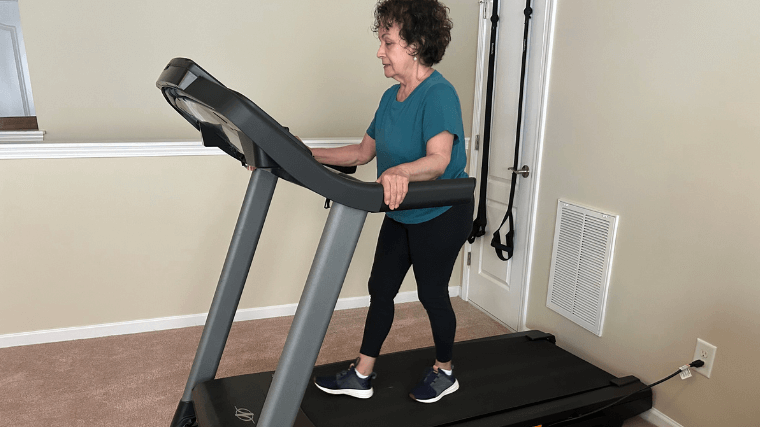What is a sedentary lifestyle? It’s a lifestyle of insufficient physical activity, and it’s estimated that 31% of the global population over the age of 14 falls within this range. (1) Dr. Raj Dasgupta, an ABIM board-certified physician, tells BarBend, “Sedentary lifestyles are more common today than they used to be. With more people working desk jobs, using technology, and driving instead of walking, physical activity has decreased. The COVID-19 pandemic also contributed to this, with more people staying indoors and working from home.”
Trading your leisure time for a workout on the best home gym equipment can be challenging, but research shows that sedentary behavior can lead to an increased risk of health problems, a risk of premature death, and potentially undesired weight gain. Let’s unpack how a sedentary lifestyle can poorly impact your health, and conversely, how an active lifestyle can boost your physical and mental well-being.
Key Takeaways
- A sedentary lifestyle can be defined as sitting, lying down, and expending little to no energy during waking hours. For wheelchair users and others with various mobility-related disabilities, there can be a wide range of options for increasing physical activity.
- Approximately 2 million deaths are attributed to physical inactivity per year, putting sedentary lifestyles among the 10 leading causes of death and disability. (2)
- One in four adults spend 70% of their days sitting. (3)
- According to the World Health Organization (WHO), 36% of American adults are sedentary, with roughly 31% of adults globally being sedentary. (2)
- Exercising for the recommended 150 minutes a week is crucial to preventing and managing chronic conditions such as cardiovascular disease, obesity, type 2 diabetes, and cancers. (3)
Statistics About Sedentary Lifestyles
There is a growing concern about the lack of physical activity in all age ranges across the globe. The Centers for Disease Control and Prevention (CDC) states that 25% of U.S. adults are not active enough to protect their health. (4) According to the WHO, two-thirds of children are insufficiently active. (2) So, why does it matter?
Our exercise frequency goes beyond the hype of being fit or keeping up with physical activity guidelines just because we’re told we should. According to the WHO, sedentary lifestyles increase all-cause mortality, double the risk of cardiovascular diseases, diabetes, and obesity, and increase the risks of colon cancer, high blood pressure, osteoporosis, lipid disorders, depression, and anxiety. (2)

A systematic review from the CDC shows that decreasing sedentary time and meeting the physical activity guidelines could potentially prevent one in 10 premature deaths. (4)
Factors such as geographical location and race-based inequities have been shown to play a role in physical inactivity. The CDC notes that 27 states have a physical inactivity prevalence of 30% or higher among non-Hispanic American Indian/Alaska Native adults. Twenty-three states and the District of Columbia have a physical inactivity prevalence of 30% or higher among non-Hispanic Black adults. (4)
Furthermore, 25 states and Puerto Rico have a physical inactivity prevalence of 30% or higher among Hispanic adults. Specifically, Alaska, Montana, and Guam have a physical inactivity prevalence of 30% or higher among non-Hispanic Asian adults. Arkansas, Kentucky, Mississippi, Oklahoma, and West Virginia have a 30% or higher physical inactivity prevalence among non-Hispanic White adults. (4)
[Related: Exercise Statistics]
Health Risks of a Sedentary Lifestyle
Being sedentary for long periods can produce a wide range of negative health impacts on the body. If you’ve never considered how a lack of movement can have consequences on your health, you might be thinking, “What happens when you don’t exercise?”
Dr. Raj Dasgupta, an ABIM board-certified physician, tells BarBend, “A sedentary lifestyle can lead to serious health problems, like heart disease, diabetes, obesity, and high blood pressure. It can also harm your mental health, increasing the chances of anxiety and depression. Not moving enough can cause poor blood circulation, weaker bones, and a higher risk of metabolic issues, which can shorten your lifespan and reduce your quality of life.”
The benefits of cardio and physical activity include a strengthened heart muscle, improved circulation, and healthy cholesterol levels, blood flow, and blood pressure. (5)

Metabolic syndrome — which can be a result of sedentary behavior — is a combination of health conditions that includes high blood pressure, high blood sugar, excess abdominal fat, and abnormal cholesterol levels that increase the risk of heart disease, stroke, and type 2 diabetes. (5)
Numerous systematic reviews have found that physical activity goes beyond the physical body by having a positive impact on mental health. (2) One 2011 study found that physical activity is consistently associated with improved physical health, life satisfaction, cognitive functioning, and psychological well-being. Conversely, physical inactivity is associated with the development of psychological disorders. (6)
Chronic diseases like colon, breast, and uterine cancers can be a result of sedentary behavior. (5) For example, the effects of being inactive can begin as a lack of bone strength and progressively result in osteoporosis.
Systematic reviews from health organizations like the CDC and the WHO reveal that sedentary behavior is a rapidly rising concern, with the WHO calling it “one of the more serious yet insufficiently addressed public health problems of our time.” (2)
[Related: How Diet and Exercise Impact Mental Health]
Signs You May Be Sedentary
Reflecting on this information, you might be wondering if the amount of time you spend sitting or being physically inactive is more than what it should be for optimal health.
Dr. Raj Dasgupta, an ABIM board-certified physician, describes some common symptoms of someone who is insufficiently active. “When you’re too sedentary, you might feel tired all the time, experience stiff muscles, gain weight, or lose flexibility,” he tells BarBend. “You might also notice poor posture, higher stress, and difficulty focusing. Over time, not moving enough can make everyday tasks harder because your muscles become deconditioned.”
Below are some signs you are out of shape and could benefit from more physical activity:
- Constipation: Excessive sitting time and inactivity can disrupt the body’s natural bowel function. Physical activity can stimulate the muscles in the intestines and promote healthy bowel movements. (7)
- Shortness of breath: Poor cardiovascular health due to being consistently inactive can make tasks difficult that involve endurance, such as climbing stairs or walking long distances.
- Feeling sluggish: Prolonged sitting can reduce blood flow, affect sleep patterns, and decrease muscle strength.
- Poor sleep: A 2017 meta-analysis concluded that prolonged sedentary behavior is associated with an elevated risk of insomnia and sleep disturbances. (8)
- High blood pressure: A sedentary lifestyle can contribute to elevated blood pressure, an increase in body weight, insulin resistance, and high levels of LDL cholesterol — all of which increase the risk of hypertension.
- Moodiness/increased anxiety: Multiple studies suggest that sedentary behavior presents an increased risk for anxiety and depression. (9)(10)
- Dull skin: Blood circulation is reduced with physical inactivity, decreasing oxygen and nutrient delivery to skin cells. A 2024 systematic review states that regular physical activity can increase blood flow to the skin, elevate skin temperature, and improve skin moisture. (11)
- Increased appetite: Physical inactivity can promote a slower metabolism, which can cause the body to signal an increase in hunger to compensate for lower energy expenditure.
- Stiff joints/back: A lack of physical activity can lead to reduced flexibility in muscles and joints, especially in older adults. Reduced flexibility can result in joints not moving through their full range of motion, leading to stiffness and discomfort.
- Weight gain: When combined with excessive caloric intake, consistent sedentary behavior leads to a caloric surplus, which can result in potentially undesired weight gain and potential obesity over time. (It’s all about the energy balance, friends.)
How to Be More Active
If you’ve determined that you’re not getting enough physical activity, you’re probably wondering how to move more to ensure physical activity guidelines are met. No matter your fitness level, there are many achievable ways to increase your energy expenditure.
“Start by making small changes. Try standing or walking while on the phone, take short breaks to stretch or move every hour, and gradually add in regular physical activities like walking or light exercises. Set simple goals and slowly increase your activity level to build a more active and healthy routine,” Dr. Raj Dasgupta tells BarBend.

Are you completely new to working out? Our beginner’s guide to the gym offers sound advice on how to start training and on proper nutrition. Of course, a public gym is not every beginner’s ideal workout space. If you’re looking to build up a home gym, we recommend starting with a pair of dumbbells.
“They are more accessible and welcoming than other types of strength training equipment,” says BarBend expert contributor Amanda Capritto, a certified personal trainer. “What I mean by that is, in my years as a personal trainer, it’s become clear to me that someone who is new to weight training or feels intimidated by weight training is more willing to pick up a dumbbell than even approach a barbell or big machine. Dumbbells offer a great introduction to weight training, especially for the apprehensive, and it is often better for people to learn foundational movement patterns with dumbbells versus other tools.”

If the thought of weights seems intimidating or unachievable, start by increasing your everyday activities, like housework, gardening, or taking the stairs instead of the elevator. Take a break during long periods of work or leisure activities — like video games and social media — to stand up and move around. As your stamina increases, try an at-home workout or invest in one of the best under-desk treadmills to use while you work.
Final Word
The rise in global and American sedentary time is a growing healthcare concern because of its massive impact on the overall health and well-being of individuals, and consequently, public healthcare systems. Public health organizations are increasing awareness of the risk factors and health concerns of a sedentary lifestyle to reduce the strain on healthcare and improve public health.
For some, simple tasks like increasing activity levels, reducing screen time, and minimizing sitting time can promote positive health outcomes. There are even achievable strategies for working folks, such as walks during breaks, in-chair exercises, and under-desk treadmills to increase your activity. Engaging in low to moderate-intensity activity can provide many health benefits and reduce or eliminate health risk factors associated with a sedentary lifestyle. (8)
Sedentary Lifestyle FAQs
How to fix a sedentary lifestyle?
Our expert, Dr. Raj Dasgupta, suggests starting with small changes and gradually adding in regular physical activities. Set goals and slowly increase your activity levels. Take time to stand up, stretch, and move around during long sitting periods.
What happens to your body when you are sedentary?
Dr. Dasgupta tells BarBend that fatigue, stiff muscles and joints, weight gain, and poor posture are all common body ailments in a sedentary lifestyle. An inactive lifestyle poses an increased risk of obesity, type 2 diabetes, cardiovascular disease, and depression and anxiety, among many other conditions.
How many hours of sitting is considered sedentary?
Many health experts and organizations define a sedentary lifestyle as spending more than 6 hours a day sitting or engaging in sedentary activities, such as watching TV, working at a desk, or playing video games without physical activity.
What are the symptoms of being too sedentary?
There are many symptoms of being too sedentary. Some examples include weight gain, constipation, dull skin, poor sleep, shortness of breath, high blood pressure, stiff joints, and an increased appetite.
How much should you walk to not be sedentary?
The CDC recommends that adults incorporate at least 150 minutes of moderate-intensity activity each week. (4) Even if you can’t meet the full guidelines, reducing any sedentary time can be beneficial to your health.
References
- Park, J. H., Moon, J. H., Kim, H. J., Kong, M. H., & Oh, Y. H. (2020). Sedentary Lifestyle: Overview of updated evidence of potential health risks. Korean Journal of Family Medicine, 41(6), 365–373.
- World Health Organization: WHO. (2002, April 4). Physical inactivity a leading cause of disease and disability, warns WHO. https://www.who.int/news/item/04-04-2002-physical-inactivity-a-leading-cause-of-disease-and-disability-warns-who
- Owen, N., Sparling, P., Healy, G., Dunstan, D., Matthews, C. (2010). Sedentary behavior: emerging evidence for a new health risk. Mayo Clin Proc. 85(12):1138-41.
- CDC Newsroom. (2016, January 1). CDC. https://www.cdc.gov/media/releases/2022/p0120-inactivity-map.html
- National Library of Medicine. (n.d.). Health risks of an inactive lifestyle. https://medlineplus.gov/healthrisksofaninactivelifestyle.html
- Carek, P., Laibstain, S., Carek, S. (2011). Exercise for the treatment of depression and anxiety. Int J Psychiatry Med. 2011;41(1):15-28.
- Iovino, P., Chiarioni, G., Bilancio, G., Cirillo, M., Mekjavic, I., Pisot, R., Ciacci, C. (2013). New onset of constipation during long-term physical inactivity: a proof-of-concept study on the immobility-induced bowel changes. PLoS One. 8(8):e72608.
- Tse, A., Wong, T., Lee, P.. (2015). Effect of Low-intensity Exercise on Physical and Cognitive Health in Older Adults: a Systematic Review. Sports Med Open. 1(1):37.
- Jiang, L., Cao, Y., Ni, S., Chen, X., Shen, M., Lv, H., Hu, J. (2020). Association of Sedentary Behavior With Anxiety, Depression, and Suicide Ideation in College Students. Front Psychiatry. 11:566098.
- Ellingson, L., Meyer, J., Shook, R., Dixon, P., Hand, G., Wirth, M., Paluch, A., Burgess, S., Hebert, J., Blair, S. (2018). Changes in sedentary time are associated with changes in mental well-being over 1 year in young adults. Prev Med Rep. 11:274-281.
- Oizumi, R., Sugimoto, Y., Aibara, H. (2024). The Potential of Exercise on Lifestyle and Skin Function: Narrative Review. JMIR Dermatol. 7:e51962.